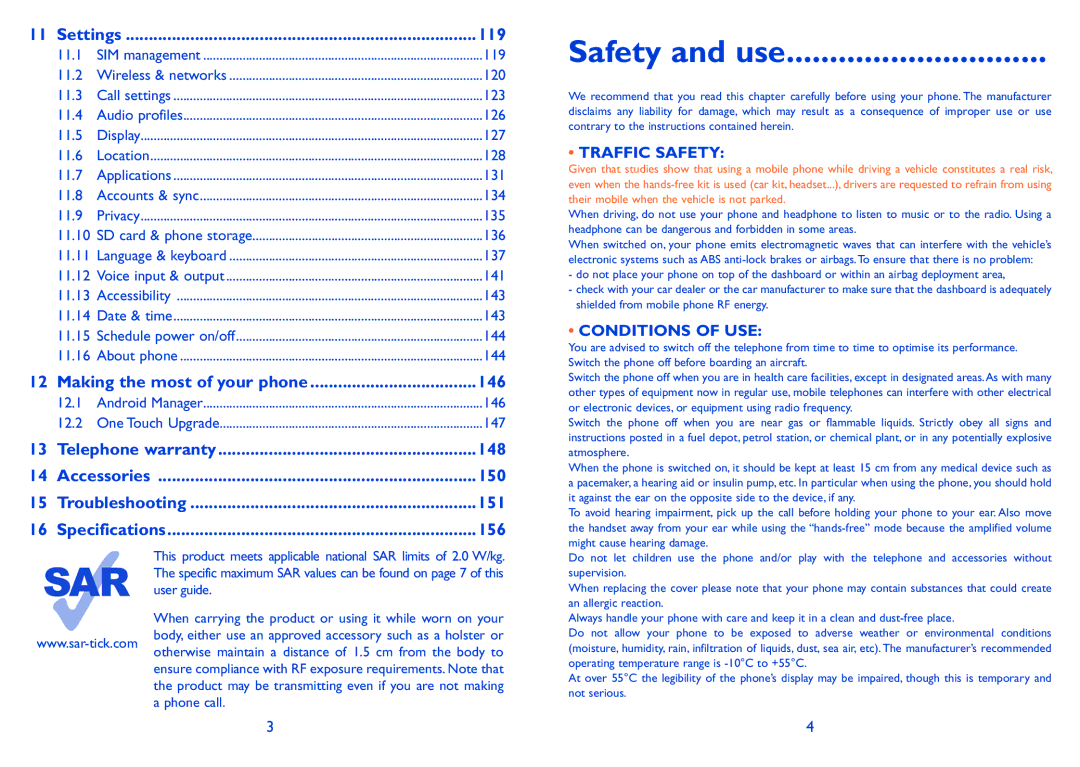
11 Settings | 119 | |
11.1 | SIM management | 119 |
11.2 | Wireless & networks | 120 |
11.3 | Call settings | 123 |
11.4 | Audio profiles | 126 |
11.5 | Display | 127 |
11.6 | Location | 128 |
11.7 | Applications | 131 |
11.8 | Accounts & sync | 134 |
11.9 | Privacy | 135 |
11.10 | SD card & phone storage | 136 |
11.11 | Language & keyboard | 137 |
11.12 | Voice input & output | 141 |
11.13 | Accessibility | 143 |
11.14 | Date & time | 143 |
11.15 | Schedule power on/off | 144 |
11.16 | About phone | 144 |
12 | Making the most of your phone | 146 | |
| 12.1 | Android Manager | 146 |
| 12.2 | One Touch Upgrade | 147 |
13 | Telephone warranty | 148 | |
14 | Accessories | 150 | |
15 | Troubleshooting | 151 | |
16 | Specifications | 156 | |
Safety and use..............................
We recommend that you read this chapter carefully before using your phone. The manufacturer disclaims any liability for damage, which may result as a consequence of improper use or use contrary to the instructions contained herein.
•TRAFFIC SAFETY:
Given that studies show that using a mobile phone while driving a vehicle constitutes a real risk, even when the
When driving, do not use your phone and headphone to listen to music or to the radio. Using a headphone can be dangerous and forbidden in some areas.
When switched on, your phone emits electromagnetic waves that can interfere with the vehicle’s electronic systems such as ABS
-do not place your phone on top of the dashboard or within an airbag deployment area,
-check with your car dealer or the car manufacturer to make sure that the dashboard is adequately shielded from mobile phone RF energy.
•CONDITIONS OF USE:
You are advised to switch off the telephone from time to time to optimise its performance. Switch the phone off before boarding an aircraft.
Switch the phone off when you are in health care facilities, except in designated areas.As with many other types of equipment now in regular use, mobile telephones can interfere with other electrical or electronic devices, or equipment using radio frequency.
Switch the phone off when you are near gas or flammable liquids. Strictly obey all signs and instructions posted in a fuel depot, petrol station, or chemical plant, or in any potentially explosive atmosphere.
When the phone is switched on, it should be kept at least 15 cm from any medical device such as a pacemaker, a hearing aid or insulin pump, etc. In particular when using the phone, you should hold it against the ear on the opposite side to the device, if any.
To avoid hearing impairment, pick up the call before holding your phone to your ear. Also move the handset away from your ear while using the
This product meets applicable national SAR limits of 2.0 W/kg. The specific maximum SAR values can be found on page 7 of this user guide.
When carrying the product or using it while worn on your body, either use an approved accessory such as a holster or otherwise maintain a distance of 1.5 cm from the body to ensure compliance with RF exposure requirements. Note that the product may be transmitting even if you are not making a phone call.
Do not let children use the phone and/or play with the telephone and accessories without supervision.
When replacing the cover please note that your phone may contain substances that could create an allergic reaction.
Always handle your phone with care and keep it in a clean and
Do not allow your phone to be exposed to adverse weather or environmental conditions (moisture, humidity, rain, infiltration of liquids, dust, sea air, etc). The manufacturer’s recommended operating temperature range is
At over 55°C the legibility of the phone’s display may be impaired, though this is temporary and not serious.
3 | 4 |
